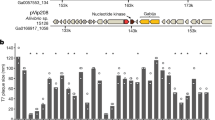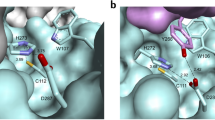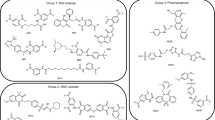Abstract
Retrovirus protease is an enzyme that cleaves gag and gag-pol precursor polyproteins into the functional proteins of mature virus particles1,2. The correct processing of precursor polyproteins is necessary for the infectivity of virus particles: in vitro mutagenesis which introduces deletions into the murine leukaemia virus genome produces a protease-defective virus of immature core form and lacking infectivity3,4. A therapeutic drug effective against disease caused by retrovirus proliferation could likewise interfere with virus maturation. The primary structure has so far been determined for the protease of avian myeloblastosis virus5, and of murine6, feline7 and bovine8 leukaemia viruses. Amino acid sequencing of the retrovirus proteases, either after their purification or from prediction from the nucleotide sequence, shows that they possess the Asp-Thr-Gly sequence characteristic of the aspartyl pro-teinases. In this report we show that retrovirus proteases belong to the aspartyl proteinase group and demonstrate an inhibition by the aspartyl proteinase-specific inhibitor, pepstatin A, on the activity of bovine leukaemia, Moloney murine leukaemia and human T-cell leukaemia virus proteases.
This is a preview of subscription content, access via your institution
Access options
Subscribe to this journal
Receive 51 print issues and online access
$199.00 per year
only $3.90 per issue
Buy this article
- Purchase on Springer Link
- Instant access to full article PDF
Prices may be subject to local taxes which are calculated during checkout
Similar content being viewed by others
References
Yoshinaka, Y. & Luftig R. B. Cell 12, 709–719 (1977).
Von der Helm, K. Proc. natn. Acad. Sci. U.S.A. 74, 911–915 (1977).
Crawford, S. & Goff, S. P. J. Virol. 53, 899–907 (1985).
Katoh, I. et al. Virology 145, 280–292 (1985).
Sauer, R. T., Allen, D. D. W. & Niall, H. D. Biochemistry 20, 3784–3791 (1981).
Yoshinaka, Y., Katoh, I., Copeland, T. D. & Oroszlan, S. Proc. natn. Acad. Sci. U.S.A. 82, 1618–1622 (1985).
Yoshinaka, Y., Katoh, I., Copeland, T. D. & Oroszlan, S. J. Virol. 55, 870–873 (1985).
Yoshinaka, Y., Katoh, I., Copeland, T. D. & Oroszlan, S. J. Virol. 57, 826–832 (1986).
Ratner, L. et al. Nature 313, 227–284 (1986).
Inouye, J. et al. Virology 150, 187–195 (1986).
Hiramatsu, K., Nishida, J., Naito, A. & Yoshikura, H. J. gen. Viol. 68, 213–218 (1987).
Shimotohno, K. et al. Proc. natn. Acad. Sci. U.S.A. 82, 3101–3105 (1985).
Moore, R., Dixon, M., Smith, R., Peters, G. & Dickson, C. J. Virol. 61, 480–490 (1987).
Yasunaga, T., Sagata, N. & Ikawa, Y. FEBS Lett. 199, 145–150 (1986).
Miyazaki, H. et al. Proc. natn. Acad. Sci. U.S.A. 81, 5999–6003 (1984).
Misono, K., Chang, J. J. & Inagami, T. Proc. natn. Acad. Sci. U.S.A. 79, 4858–4862 (1982).
Toh, H., Ono, M., Saigo, K. & Miyata, T. Nature 315, 691 (1985).
Umezawa, H. et al. J. Antibiot., Tokyo 23, 259–262 (1970).
Ragagopalan, T. G., Stein, W. H. & Moore, S. J. biol. Chem. 241, 4295–4297 (1966).
Misono, K. S. & Inagami, T. Biochemistry 19, 2616–2622 (1980).
Yoshinaka, Y. & Luftig, R. B. Virology 111, 239–250 (1981).
Aoyagi, T. et al. J. Antibiot., Tokyo 26, 539–541 (1973).
Yoshinaka, Y. & Luftig, R. B. Biochem. biophys. Res. Commun. 76, 54–56 (1977).
Foltmann, B. & Pederson, V. B. in Acid Proteases: Structure, Function and Biology (ed. Tang, J.) 3–22 (Plenum, New York, 1977).
Yokosawa, H., Holladay, L. A., Inagami, T., Haas, E. & Murakami, K. J. Biol. Chem. 225, 2498–3502 (1980).
James, M. N. G. & Sielecki, A. R. J. molec. Biol. 163, 299–361 (1983).
Yoshinaka, Y. & Luftig, R. B. J. gen. Virol. 48, 329–340 (1980).
Yuasa, Y., Shimojo, H., Aoyagi, T. & Umezawa, H. J. natn. Cancer Inst. 54, 1255–1256 (1975).
Stephens, R. M., Casey, J. W. & Rice, N. R. Science 231, 589–594 (1986).
Power, M. D. et al. Science 231, 1567–1572 (1986).
Author information
Authors and Affiliations
Rights and permissions
About this article
Cite this article
Katoh, I., Yasunaga, T., Ikawa, Y. et al. Inhibition of retroviral protease activity by an aspartyl proteinase inhibitor. Nature 329, 654–656 (1987). https://doi.org/10.1038/329654a0
Received:
Accepted:
Issue Date:
DOI: https://doi.org/10.1038/329654a0
This article is cited by
-
MpSaci is a widespread gypsy-Ty3 retrotransposon highly represented by non-autonomous copies in the Moniliophthora perniciosa genome
Current Genetics (2015)
-
Whiskers-less HIV-protease: a possible way for HIV-1 deactivation
Journal of Biomedical Science (2013)
-
Identification and occurrence of the LTR-Copia-like retrotransposon, PSCR and other Copia-like elements in the genome of Phytophthora sojae
Current Genetics (2009)
-
Mechanisms of leukemogenesis induced by bovine leukemia virus: prospects for novel anti-retroviral therapies in human
Retrovirology (2007)
-
The role ofCandida albicans secreted aspartic proteinase in the development of candidoses
Journal of Molecular Medicine (1996)
Comments
By submitting a comment you agree to abide by our Terms and Community Guidelines. If you find something abusive or that does not comply with our terms or guidelines please flag it as inappropriate.



